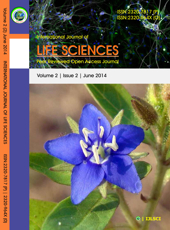Eichhornia and Ipomoea: Efficient phytoremediators of manganese
Keywords:
Phytoremediation, Eichhornia, Ipomoea, adsorption, contact timeAbstract
Phytoremediation uses plants to remove pollutants from the environment. The content of heavy metals in the biosphere has been increasing over the past hundred years due to the economic activity of man. Manganese is one of the heavy metals which is toxic but then too necessary in trace amounts for all living organisms. However accumulation of this heavy metal is not ignorable. To maintain the balance of manganese in the environment phytoremediation of manganese is the most cost effective method. Leaves of two aquatic plant species viz. Eichhornia crassipes and Ipomoea aquatica were used as research tool for removal of manganese ions. The removal is dependent on the rate of adsorption by the leaves. Filtrate of leaves was used for various chemical tests and estimation of Mn by Ammoniumpersulphate method and volumetric analysis. Eichhornia gives better results as compared to Ipomoea. This was due to the increase in the adsorption capacity at higher dose of adsorbent. The removal of Mn ions from aqueous solutions using powder of different waste materials viz., Ipomoea leaves and water hyacinth was found to be increased on adsorbent dosage, initial concentration of sorbate, pH and contact time. As far as contact time is concerned Ipomoea showed better results for largest removal of manganese ions in comparison to Eichhornia.
Downloads
References
1. Badruzzaman SM, Husain W (1992) Some aquatic and marshy land medicinal plants from Hardoi district of Uttar Pradesh. Fitoterapia, 63(3): 245-247.
2. Hinchman RR (1994) Phytoremediation : use of green plants to clean up contaminated soil; groundwater and wastewater, Applied J. Natural Sciences, 1-10.
3. Huang JW, Cunningham SD (1996) Lead Phytoextraction: Species Variation in Lead Uptake and Translocation,” The New Phytologist, 134(1) : 75- 84.
4. Lasat MM (2000) Phytoextraction of Metals from Contami- nated Soil: A Review of Plant/Soil/Metal Interaction and Assessment of Pertinent Agronomic Issues,” Journal of Hazardous Substance Research, 2 (5): 1-25.
5. Mishra V, Upadhyay A, Pathak V, Tripathi B (2008) Phytoremediation of mercury and arsenic from tropical opencast coalmine effluent through naturally occurring aquatic macrophytes. Water air soil polllut., 193: 303-314.
6. Moffat AS (1995) Plants Proving Their Worth in Toxic Metal Cleanup,” Science, 9(2): 302-303.
7. Muramoto S, Oki Y (1983) Removal of some heavy metals from polluted water by water hyacinth (Eichhornia crassipes). Bull. Environ. Contam. Toxicol. 30: 170–177.
8. Nirmal Kumar JI, Soni H, Kumar RN (2006) Biomonitoring of selected freshwater macrophytes to assess lake trace element contamination: A Case Study of Nal Sarovar Bird Sanctuary, Gujarat, India,J. Limnol., 65(1): 9-16.
9. Raskin L, Robert D Smith, David E Salt (1997) Phytoremediation of metals using plants to remove pollutants from the environment, Current options in Biotechnology, 8: 221-226.
10. Reddy KR, Agami M, D’Angelo EM, Tucker JC (1991) Influence of potassium supply on growth and nutrient storage by water hyacinth. Bioresource Technology, 39 (1): 79–84.
11. Sykes MY, Vina BJ, Abubakr S (1999) Biotechnology: Working with Nature to Improve Forest Resources and Products,” International Vetiver Conference, 4-8 February 1999, Chiang Rai, pp. 631-637.
12. Xia H, Ma X (2005) Phytremediation of ethion by water hyacinth (Echhornia crassipes) from water. Bioresour Technology. College of Food Sciences, Biotechnology and Environmental Engineering, Zhiejang Ghongshang University, Hangzou.
Downloads
Published
How to Cite
Issue
Section
License
Copyright (c) 2014 Authors

This work is licensed under a Creative Commons Attribution-NonCommercial-NoDerivatives 4.0 International License.
Open Access This article is licensed under a Creative Commons Attribution 4.0 International License, which permits use, sharing, adaptation, distribution and reproduction in any medium or format, as long as you give appropriate credit to the original author(s) and the source, provide a link to the Creative Commons license, and indicate if changes were made. The images or other third party material in this article are included in the article’s Creative Commons license unless indicated otherwise in a credit line to the material. If the material is not included in the article’s Creative Commons license and your intended use is not permitted by statutory regulation or exceeds the permitted use, you will need to obtain permission directly from the copyright holder. To view a copy of this license, visit http://creativecommons.org/ licenses/by/4.0/











